Foundations of Nursing 1
Subtopic:
Medical Waste Disposal and Management

Learning Objectives
Define healthcare waste and explain its classification (by state, degradability, and health/environment impact).
Identify major and minor sources of healthcare waste, including institutions and clinical settings.
Explain the waste management hierarchy, from prevention to disposal, and understand each step’s purpose.
Describe waste management steps: generation, segregation, collection, transportation, treatment, and disposal.
Classify healthcare waste types using WHO categories (e.g., infectious, chemical, pharmaceutical, radioactive).
Demonstrate proper waste segregation techniques, including color-coded bin systems for different waste types.
Outline collection and handling procedures, emphasizing documentation, sanitation, and storage time limits.
Recognize safe transportation methods, including sealed containers and dedicated waste routes.
Understand various treatment and disposal methods, such as incineration, autoclaving, chemical disinfection, and land disposal.
Apply labeling and hazard symbols to ensure safe waste identification and processing.
WASTE MANAGEMENT
Waste is any material – solid, liquid, or gas – that is unwanted and/or unvalued, and has been discarded or discharged by its owner.
Healthcare Waste refers to all types of waste from all health care activities; waste generated by the health care facilities, research facilities and laboratories. Healthcare waste is also known as biomedical waste, infectious waste or medical waste. Healthcare waste is also known as biomedical waste, infectious waste or medical waste. The large volumes of health care waste if not managed properly can lead to a global hazard. This could not only lead to the spread of highly contagious diseases but the hazardous chemical waste produced by the use of items can cause considerable damage to the ecosystem and the environment.
Classification of wastes
Classification according to matter state (properties)
- Solid waste includes common household waste (including kitchen and garden waste), commercial and industrial waste, sewage sludge, construction and demolition waste, waste from agriculture and food processing, and mine and quarry tailings.
- Liquid waste includes domestic waste water (liquid kitchen, laundry, and bathroom waste), storm water, used oil, and waste from industrial processes.
- Gaseous waste comprises gasses and small particles emitted from open fires, incinerators, and vehicles, or produced by agricultural and industrial processes.
Classification of wastes- general according to their degradability
- Bio-degradable : Whether they can be degraded by physical or biological means (paper, wood, fruits and others).
- Non-biodegradable; These cannot be degraded easily by physical or biological means (plastics, bottles, old machines, cans, Styrofoam containers and others).
Classification according to their Effects on Human Health and the Environment
- Hazardous wastes : Substances unsafe to use commercially, industrially, agriculturally, or economically that are shipped, transported to or brought from the country of origin for dumping or disposal in, or in transit through, any part of the world.
Non-hazardous : Substances safe to use commercially, industrially, agriculturally, or economically that are shipped, transported to or brought from the country of origin for dumping or disposal in, or in transit through, any part of the world.
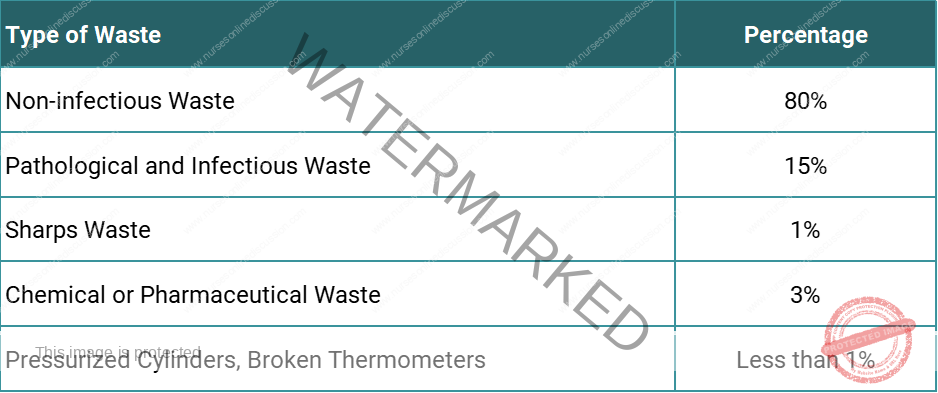
Sources of Healthcare Waste
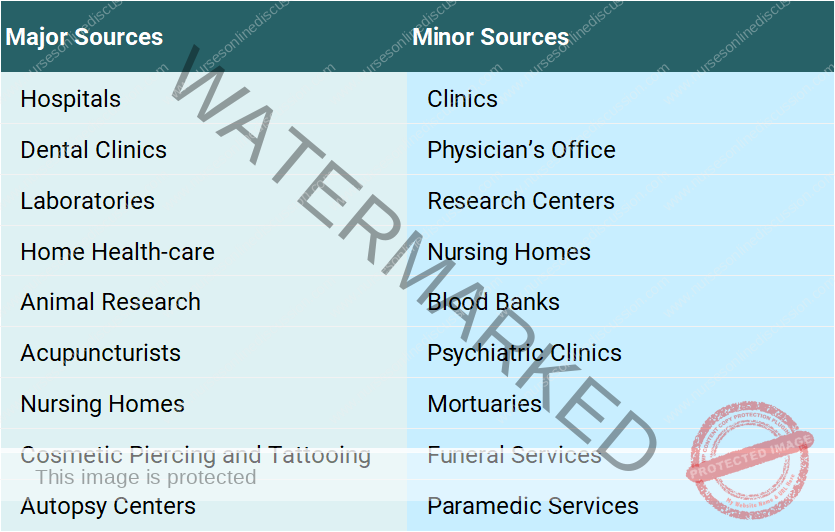
Sources of health care waste
Major sources
- Hospitals
- Clinics
- Laboratories
- Research centers
- Animal Research
- Blood banks
- Nursing Homes
- Mortuaries
- Autopsy centers Minor sources
- Dental clinics
- Physician’s office
- Home health-care
- Nursing homes
- Acupuncturists
- Psychiatric clinics
- Cosmetic piercing and tattooing
- Funeral services
- Paramedic services
- Institutions for disabled persons
WASTE MANAGEMENT HIERARCHY
Waste management hierarchy is a structured approach to prioritize and manage waste by minimizing its environmental impact.
It consists of several key steps, listed in descending order of priority
Waste management hierarchy is defined as the order of preference for action to reduce and manage waste and is usually presented diagrammatically in the form of a pyramid. The aim of waste hierarchy is to extract the maximum practical benefits from products and to generate a minimum amount of waste.
- Prevention/avoidance: This concept focuses on the measures to be taken so as not to create any type of wastes in the first place e.g. avoiding to eat from the ward. This is given the top priority in the waste management program.
- Reduction of Wastes/minimization: According to this concept, the health care setting should reduce or minimize the amount of waste or the toxicity of wastes e.g. avoiding to use gloves in procedures that don’t necessary need one to use gloves and companies should take action to make changes in the type of materials that are being used for the production of the specific products, so as to ensure that the by-products are of the least toxicity.
- Reuse: Reuse is another effective Solid waste management strategy, in which the waste is not allowed to enter into the disposal system. The wastes are collected in the middle of the production phase and are again fed along with the source to aid in the production process e.g. Autoclaving metal instruments or sterilization of medical equipment.
- Recycle: In the recycling strategy, the waste materials are implemented in the production of a new product. In this process, the waste materials of various forms are collected and then processed. Post processing, they enter into the production lines to give rise to new products. This process prevents pollution and saves energy.
- Energy Recovery: The energy recovery process is also called waste to energy conversion. In this process; the wastes that cannot be recycled are being converted into usable forms of energy such as heat, light and electricity etc. This helps in the saving of various natural resources. Various processes such as combustion, anaerobic digestion, landfill gas recovery, pyrolization and gasification are being implemented to carry out the conversion process.
- Treatment and Disposal: The disposal process holds the last position in the waste management hierarchy. Landfills are the common form of waste disposal.
Waste Management Steps/Waste Stream
Waste stream refers to the systematic steps followed in health care solid waste management from its generation to its final disposal.
1.Generation: Non-Hazardous waste/General waste : Office, Kitchen, Administrative, Municipal/Public Areas, Hostels, Store Authorities, Restrooms, etc. Hazardous (Infectious & toxic waste) : Wards, Treatment Rooms, Dressing Rooms, OT ICU, Labour Room, Laboratory, Dialysis Room, CT Scan, Radio-imaging, etc. WHO Classification
2 Segregation: Waste segregation is the practice of separating different types of waste at the source to ensure proper handling and disposal. Done at the point of waste generation and placed in separate colored bags. Color coding may vary by nation or hospital.
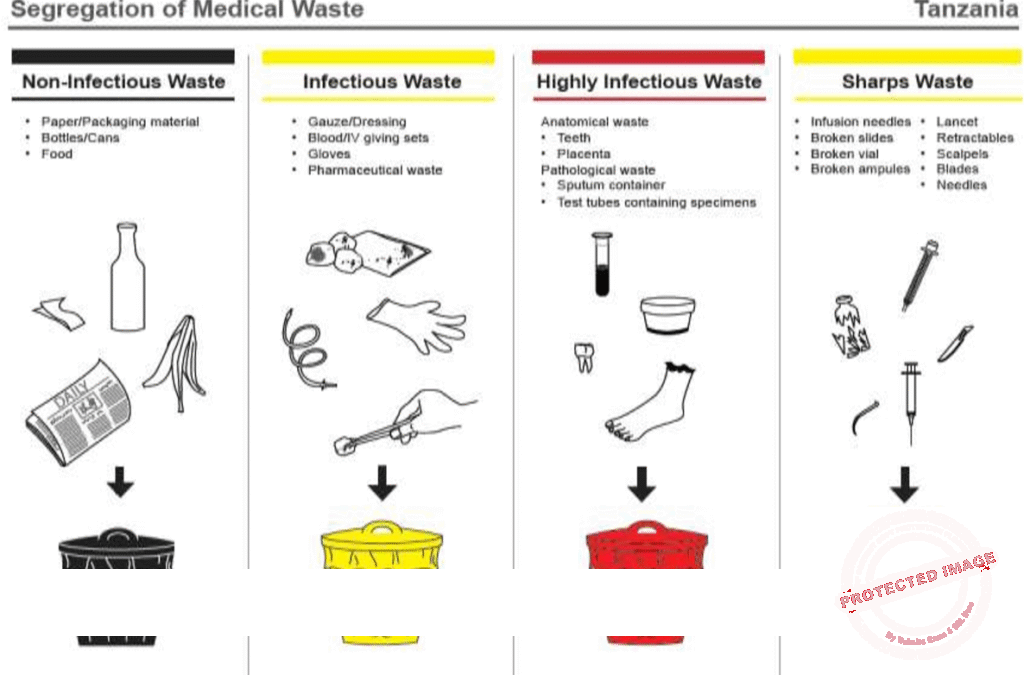
| Color | Type of Waste | Container |
|---|---|---|
| Yellow | Infectious waste, pathological waste | Non-chlorinated plastic bags |
| Red | Contaminated recyclable waste (e.g., tubing) | Autoclavable plastic containers/bags |
| White (Translucent) | Sharps (needles, blades, scalpels) | Puncture-proof, leak-proof containers |
| Blue | Glassware and metallic body implants | Cardboard boxes with blue marking |
| Black/Green | General (non-hazardous) waste | Normal plastic bags or containers |
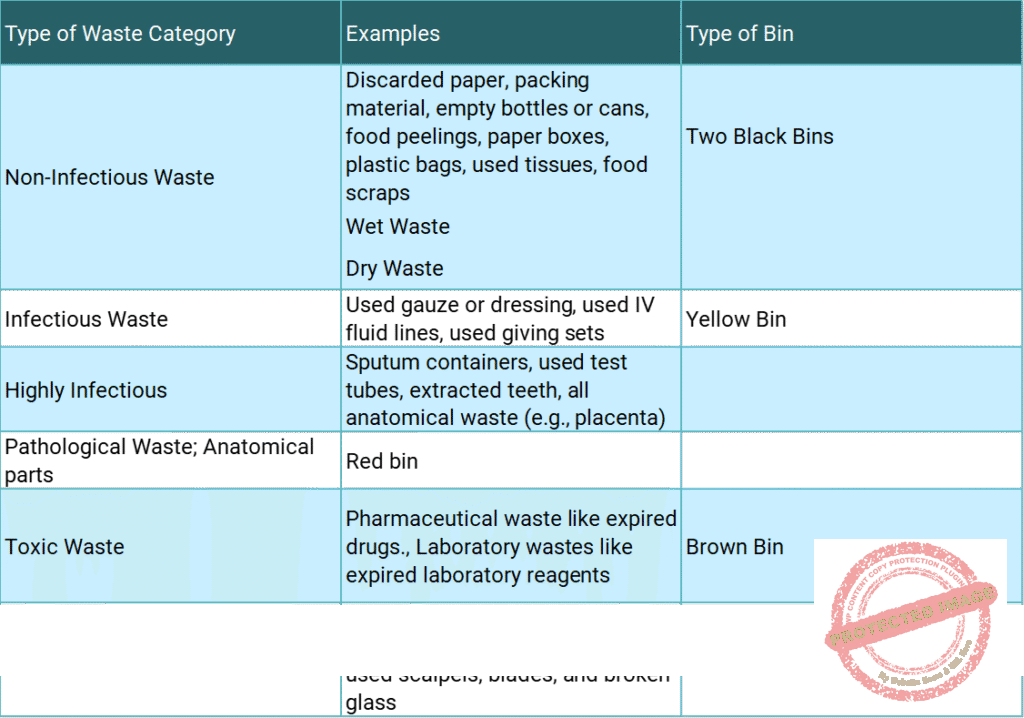
3.Collection or Handling of Waste: Waste collection is the systematic gathering of various types of medical waste.
4.Handling concerns the collection, weighing and storing conditions. Trained sanitation personnel, often supervised by nursing staff and sanitation supervisors, manage this process. They ensure waste is correctly segregated at the point of generation into appropriate color-coded bins.
Proper documentation is maintained in a register to track waste quantity and type. Regular cleaning and disinfection of garbage bins are essential for maintaining hygiene. The waste collection process is conducted in compliance with safety regulations and guidelines, ensuring the protection of personnel and the environment. This systematic collection is a crucial step in the safe and efficient management of medical waste. Waste should not be stored in the generation area for more than 4-6 hours. Waste collected in various areas is prepared for transport or disposal/treatment.
- Transportation : Hospitals should have a separate corridor and lift dedicated to carrying and transporting waste. General waste is deposited at municipal dumps.
- Waste designated for autoclaving and incineration is disposed of at a separate site for external transport (using distinct colored plastic bags).
- Transportation is carried out in sealed containers to prevent leakage.
- Treatment & Disposal: Waste disposal in hospitals is the final phase in the systematic management of medical waste. It involves the safe and environmentally responsible removal or destruction of waste, ensuring it no longer poses health risks to patients, staff, and the community.
- General waste is dumped at municipal dumping sites.
- The sanitation officer is responsible for coordinating with municipal authorities for proper disposal.
- Use of labels/symbols helps in identifying waste for treatment (e.g., Risk of Corrosion, Danger of Infection, Toxic Hazards, Glass Hazards, Radioactive Materials, etc.).
TREATMENT AND DISPOSAL TECHNIQUE FOR HEALTH CARE WASTE
- Incineration
- Chemical disinfection
- Wet & dry thermal treatment (Autoclave)
- Microwave irradiation
- Land disposal
- Inertization
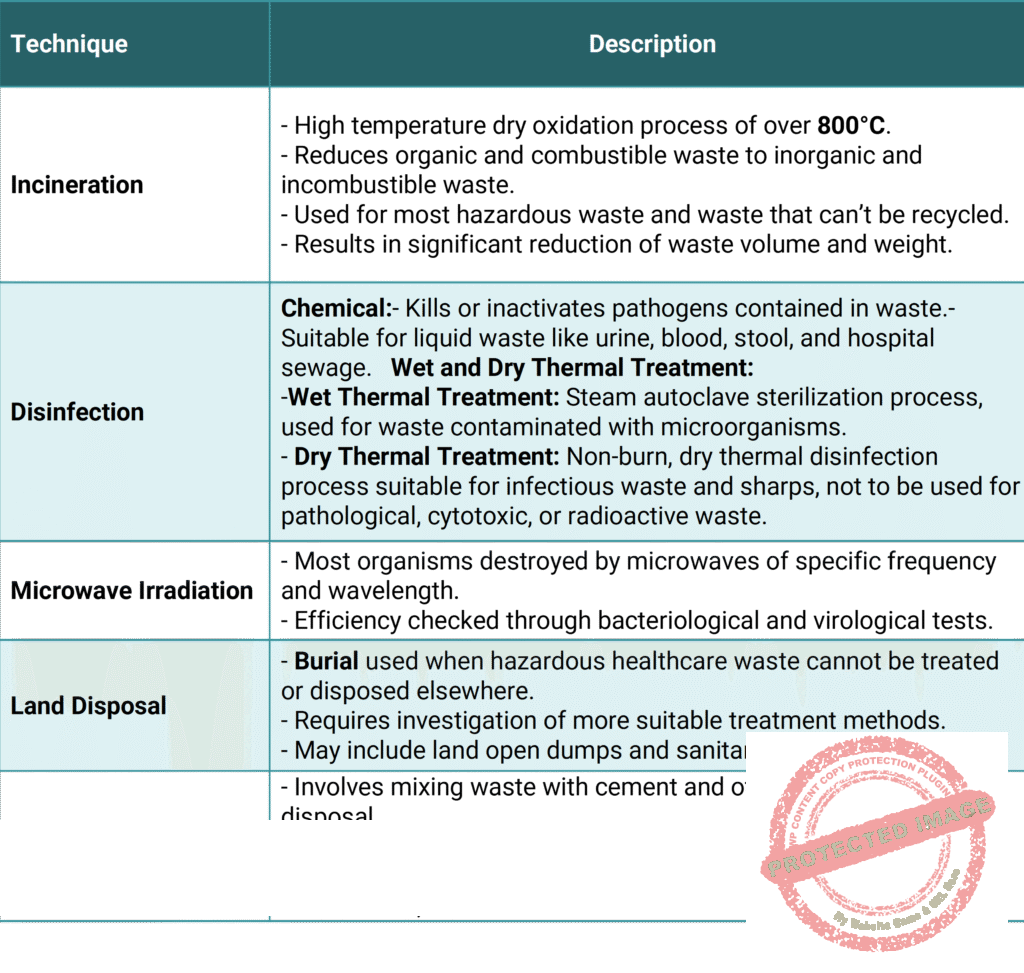
Treatment and Disposal Methods
Treatment methods depend on the type and risk level of the waste.
1. Incineration
Burns waste at high temperatures
Suitable for pathological, pharmaceutical, and certain infectious wastes
Produces ash, flue gases, and heat
Risks: Can emit toxic gases if not properly maintained
2. Autoclaving (Steam Sterilization)
Uses saturated steam under pressure
Common for treating microbiological waste, sharps, and certain plastics
Environmentally friendly compared to incineration
3. Chemical Disinfection
Uses chemical agents (e.g., chlorine) to disinfect liquid waste or sharps
Used mainly in laboratories
4. Microwave Treatment
Uses microwave energy to heat and destroy pathogens
Suitable for non-metallic infectious waste
5. Land Disposal
Treated waste is buried in secured landfills
Pathological waste may be buried in deep burial pits
6. Encapsulation
Sharps or pharmaceuticals are sealed in containers filled with cement or other binding agents
Prevents leaching into soil or water
Legal and Regulatory Framework
Medical waste management is governed by laws and policies at both national and international levels to ensure safety and accountability.
1. WHO Guidelines
The World Health Organization provides comprehensive guidance on safe management of healthcare waste, especially for low-resource settings.
2. National Policies (country-specific)
Most countries have specific Healthcare Waste Management Guidelines, which outline:
Standards for segregation
Treatment protocols
Responsibilities of healthcare workers and waste handlers
Licensing of waste disposal contractors
3. Occupational Health and Safety
Regulations require training, PPE use, and vaccination (e.g., hepatitis B) for healthcare workers exposed to medical waste.
Role of Nurses in Medical Waste Management
Nurses play a pivotal role in all stages of medical waste handling. Their responsibilities include:
1. Waste Segregation
Correct identification and disposal of waste according to color codes
2. Patient Education
Educating patients and caregivers (especially in home care) about safe disposal of waste like syringes or wound dressings
3. Compliance Monitoring
Ensuring protocols are followed by junior staff and support workers
4. Reporting and Documentation
Reporting needle-stick injuries or incidents of poor waste management
Keeping records for internal audits and external inspections
5. Infection Control
Acting as advocates for infection prevention
Participating in infection control committees
6. Training and Supervision
Conducting and attending training sessions on waste handling and safety
Personal Protective Equipment (PPE) for Waste Handling
To minimize exposure, appropriate PPE must be used during waste handling:
Gloves (heavy-duty rubber or nitrile)
Masks and face shields
Waterproof aprons or gowns
Closed shoes or boots
Eye protection when dealing with splashes
Challenges in Medical Waste Management
1. Lack of Awareness
Inadequate knowledge among healthcare workers, especially support staff
2. Poor Infrastructure
Lack of incinerators, autoclaves, or waste containers in rural or low-resource settings
3. Financial Constraints
Budget limitations for proper treatment facilities or PPE
4. Informal Waste Handling
Scavenging or unregulated disposal by informal waste collectors
5. Resistance to Change
Staff may neglect segregation due to workload or poor supervision
Best Practices for Nurses and Healthcare Facilities
Establish written policies and protocols
Use clearly labeled bins and signage
Regularly audit waste segregation and disposal processes
Provide continuous staff education and training
Ensure timely collection and treatment of waste
Collaborate with certified waste disposal companies
Join Our WhatsApp Groups!
Are you a nursing or midwifery student looking for a space to connect, ask questions, share notes, and learn from peers?
Join our WhatsApp discussion groups today!
Join NowRelated Topics
- History of Nursing
- The Role of the Nurse
- Code of Conduct for Nurses
- Principles of Professional Nursing Ethics and Etiquette
- Patient’s Rights
- Nursing and the Law
- Nursing Standards and Qualities of a Nurse
- General Principles and Rules of All Nursing Procedures
- Hospital Economy
- Use of Personal Protective Equipment
- Routine and Weekly Cleaning of the Ward
- Waste Management and Disposal
- Isolation of Infectious Patients
- Causes of Infection
- Medical Waste Disposal and Management
- Cleaning Methods
- Carry out Adequate Feeding of Patients
- Perform Bladder and Bowel Care
- Passing a Flatus Tube
- Administration of Enema
- Ward Report
- Lifting/Positioning a Patient
- Tepid Sponging
- General Principles in Patient Care
- Ethics in Nursing Care
- Principles of Infection Prevention and Control
- Body Mechanics
- Bed Making
- Vital Observations
- Bed Bath
- Oral Care/Mouth Care
- Care and Treatment of Pressure Ulcers
Get in Touch
(+256) 790 036 252
(+256) 748 324 644
Info@nursesonlinediscussion.com
Kampala ,Uganda
© 2025 Nurses online discussion. All Rights Reserved Design & Developed by Opensigma.co

